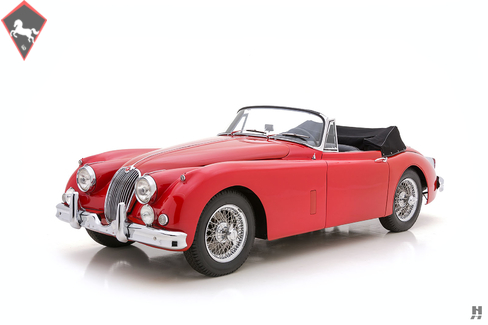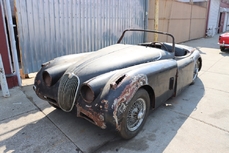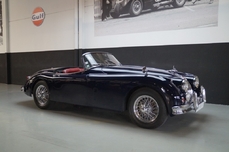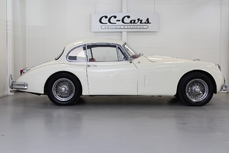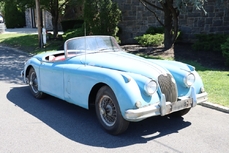Jaguar XK150 Drophead 1960
General description :
For many years, the Jaguar XK150 lived somewhat in the shadow of its older sibling, the XK120. After all, the XK120 established Jaguar’s credibility in the United States and was elemental to the sports car boom of the late 1940s. But as much as collectors and enthusiasts have celebrated the XK120, the XK150 was always the thinking person’s choice, quietly offering superior comfort, braking, handling, and refinement. As the final evolution of the XK range, the 150 is the most usable and best developed, offering four-wheel disc brakes, telescopic dampers, and rack-and-pinion steering. For the majority of XK150 production, the 3.4-litre engine (shared with the XK140 M) was the standard fitment. However, the final batch of cars featured the larger and more powerful 3.8-litre engine developed for the upcoming E-Type. Today, the XK150 has emerged as a standout collector car, offering a distinct combination of superlative performance and elegance that make it unmistakably a Jaguar.
Offered here is a splendid XK150 with the versatile and lovely drophead coupe body, and the rare, highly desirable 3.8-litre engine. According to the accompanying Jaguar Daimler Heritage Trust certificate, this car was produced in February 1960 and dispatched for Jaguar Cars, New York, about a month later. The factory build records show this is a genuine 3.8-litre car equipped with the extremely rare optional Borg-Warner automatic gearbox. Originally finished in cream over blue trim, it was the recipient of a comprehensive restoration and is now finished in a striking combination of Carmen Red with black upholstery and hood. The older restoration is well-maintained and has mellowed gently, giving the car an appealing character that invites regular use. The red paintwork is in excellent order all around, with good detailing and finish quality. The brightwork and body fittings are in similarly good condition, and exterior details include correct Lucas headlights and fog lamps, chrome exhaust tips, and beautiful chrome wire wheels fitted with period-correct Pirelli Cinturato tires that provide the proper stance and handling characteristics.
The primary appeal of the XK150 is that it offers considerably more space and comfort compared to its older brethren, making it the ideal choice for drivers. This example features a pleasingly well-restored cabin, trimmed in the proper materials, including leather seats, wool carpets, and vinyl coverings on the door panels and dash. The seats display a bit of light creasing consistent with regular use, while some minor wear is noted on the driver’s outer bolster. Greeting the pilot is a factory-correct four-spoke steering wheel and an array of Smiths instruments in the central fascia, which is correctly trimmed in gray vinyl. For the first time in an XK sports car, there was no wood trim offered across the range. Jaguar employed an unusual but creative solution for the gear selector, mounting it horizontally on the dash, just below the gauges. The black canvas soft fits well and is insulated and lined with a broadcloth headliner to reduce noise, and includes a matching canvas boot cover. A period-correct tool kit accompanies the sale.
Per the Heritage Certificate, the original numbers-matching 3.8-litre inline-six remains in its rightful place under the bonnet. The engine displays a slight patina from age and use, yet it is quite tidy, properly-detailed, and attractive – dressed in its signature polished alloy cam covers and twin SU carburetors. It runs well, with the smoothness and ample low-end torque that defines Jaguar’s legendary big ‘six.
With its powerful 3.8-litre engine and rarely-seen automatic gearbox, this XK150 falls firmly on the Grand Touring side of the XK-series scale, providing its occupants with relaxed, easy-going performance with all of the style and character that enthusiasts expect from these iconic Jaguars.
Offers welcome and trades considered
https://hymanltd.com/vehicles/6761
1960 Jaguar XK150 Drophead is listed sold on ClassicDigest in St. Louis by Mark Hyman for $119500.
Car Facts
Car type : Car Make : Jaguar Model : XK150 Model Version : Drophead Engine size : 0.0 Model Year : 1960 Location : Missouri
Sold
Seller Information
Sold
People who viewed this Jaguar XK150 also viewed similar Jaguar listed at ClassicDigest
Other cars listed for sale by this dealer
About Jaguar
Ah, the story of Jaguar, from its early days as the SS Cars Ltd. to its pinnacle with the D-type, and the street-going evolution in the form of the iconic E-type. There's something quintessentially British about this tale, and I'll narrate it as a British journalist might.In the Beginnings:
Our journey into the world of Jaguar begins in the 1930s, when a company known as SS Cars Ltd. emerged. Despite the unfortunate coincidence of their initials with the rising political tensions in Europe, they started producing stylish and performance-oriented cars. The SS 100, introduced in 1936, was a symbol of elegance and speed, setting the stage for what would become Jaguar.
The Birth of Jaguar:
As the shadows of World War II loomed, SS Cars Ltd. wisely decided to disassociate themselves from the SS initials. Thus, in 1945, they officially became Jaguar Cars Ltd., a name that would soon be synonymous with British luxury and performance.
The XK Series:
Jaguar's post-war era brought us the XK 120, a true sensation in 1948. With its sleek design and a powerful 3.4-liter inline-six engine, it became the world's fastest production car. The XK 120 was the blueprint for what lay ahead – Jaguars that blended style with speed in a uniquely British fashion.
The D-type Dominance:
Then came the D-type, a true racing legend. Introduced in 1954, it won Le Mans three times in the 1950s, showcasing Jaguar's engineering prowess. With its innovative monocoque construction and the iconic fin at the back, the D-type was the apex of Jaguar's motorsport success.
The E-type Emergence:
But the true turning point arrived in 1961 with the introduction of the E-type, often described by Enzo Ferrari as "the most beautiful car ever made." Its long bonnet, curvaceous body, and a 3.8-liter engine delivering exhilarating performance made it an instant classic. The E-type was not just a car; it was a work of art on wheels, and it could hit 150 mph on the road.
Street and Racing Success:
The E-type's beauty was matched by its capability on the track. The lightweight E-types were particularly successful in various racing events, cementing Jaguar's reputation as a force to be reckoned with in motorsport.
The Age of Refinement:
As we delve deeper into the Jaguar story, we find that the 1950s and 1960s were an age of refinement and expansion. Alongside the magnificent D-type and the E-type's iconic emergence, Jaguar introduced models that further solidified its reputation for luxury and performance.
The MK2:
In the late 1950s, Jaguar unveiled the MK2, a sports sedan that combined elegance with power. This sleek four-door saloon was a favorite of bank robbers and law enforcement alike, thanks to its exceptional speed and handling. The MK2 was a symbol of Jaguar's ability to blend sophistication with performance and had a successful racing career as well.
The XJ6:
Fast forward to 1968, and Jaguar launched a car that would define luxury saloons for decades to come – the XJ6. It was a masterpiece of engineering and design, featuring a smooth inline-six engine, independent rear suspension, and a spacious, beautifully appointed interior. The XJ6 was a symbol of British elegance and provided a ride so smooth that it seemed to glide over the road. It became the flagship model for Jaguar and set the standard for luxury saloons, showcasing a level of refinement that left competitors in awe.
The Blend of Classic and Modern:
While the MK2 and XJ6 represented the evolution of Jaguar's saloon cars, they maintained the brand's commitment to performance and luxury. These cars didn't just belong on the racetrack; they were equally at home cruising down the grand boulevards or gliding through the English countryside.
The Challenges of Change:
However, as the 1970s arrived, Jaguar, like many British automakers, faced financial challenges and changes in ownership. The British Leyland era brought both opportunities and struggles, as the brand navigated through various mergers and transitions.
Nevertheless, the legacy of the MK2 and XJ6, along with the D-type and E-type, continues to define Jaguar as a manufacturer that combines timeless elegance with a spirit of performance. These classic models, whether driven on winding roads or parked as collectors' treasures, serve as a testament to Jaguar's enduring presence in the world of automotive excellence.
The Jaguar story, from its early days as SS Cars Ltd. to the creation of automotive icons like the E-type, MK2, and XJ6, is a journey that reflects the very essence of British motoring – a blend of luxury, power, and style that continues to captivate enthusiasts and connoisseurs alike.
